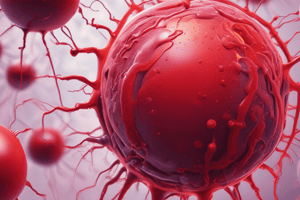Podcast
Questions and Answers
What are the three stages of hemostasis?
What are the three stages of hemostasis?
Primary Hemostasis, Secondary Hemostasis, Fibrin Stabilization and Fibrinolysis
Which pathway involves initiation of coagulation in vivo?
Which pathway involves initiation of coagulation in vivo?
- Common pathway
- Extrinsic pathway (correct)
- Intrinsic pathway
- Fibrinolysis pathway
What is thrombocytopenia?
What is thrombocytopenia?
Thrombocytopenia is defined as a platelet count below the lower limit of normal.
Which of the following are examples of platelet function disorders?
Which of the following are examples of platelet function disorders?
Study Notes
Bleeding Disorders
- Bleeding disorders can be classified into vascular defects, abnormalities of platelet number or function, clotting factor deficiencies, and combinations of these disorders.
Stages of Hemostasis
- Primary Hemostasis: • Involves platelets and VWF • Goal is rapid cessation of bleeding • Involves adhesion, activation, and aggregation of platelets
- Secondary Hemostasis: • Reinforces the platelet plug with a fibrin clot • Involves the extrinsic and intrinsic pathways, which converge onto the common pathway
- Fibrin Stabilization: • Converts soluble fibrin to an insoluble, cross-linked clot
- Fibrinolysis: • Dissolves the clot once healing is initiated
Three Phases of Haemostasis
- Vascular Phase: • Blood vessels contract in response to injury
- Platelet Phase: • Platelets attach to the injured endothelium, stick to each other, and become activated
- Coagulation Phase: • A complex series of steps produces a fibrin clot
Causes of Bleeding Disorders
- Vascular Defects: • Congenital: Ehlers-Danlos syndrome • Acquired: senile purpura, vasculitis, scurvy
- Platelet Disorders: • Decreased marrow production: aplastic anaemia, megaloblastic anaemia • Excess destruction: ITP, liver disease, infection, autoimmune disorders • Poorly functioning platelets: NSAIDS, sulphonamides
- Coagulation Disorders: • Congenital: haemophilia, connective tissue disease • Acquired: liver disease, DIC, vitamin K deficiency, anticoagulants
Pattern of Bleeding
- Vascular and Platelet Disorders: • Prolonged bleeding from cuts, skin bleeding, bleeding from mucous membranes
- Coagulation Disorders: • Delayed bleeding into joints and muscle
Vascular Defects
- Hereditary Haemorrhagic Telangiectasia: • AD disease • Mutations in angiogenic genes • Telangiectasia and small aneurysms on fingertips, face, and tongue • Patients present with recurrent bleeds and iron deficiency
- Vascular Ehlers-Danlos Disease: • AD disorder • Defect in type 3 collagen • Fragile blood vessels and organ membranes • Bleeding and organ rupture
- Scurvy: • Vitamin C deficiency • Affects collagen synthesis • Characterized by petechial haemorrhage, bruising, and subperiosteal bleeding
Platelet Disorders
- Approach to Platelet Disorders: • Decreased platelet function (normal count) • Low platelet count
- Platelet Function Disorders (Normal Count): • Congenital: von Willebrand disease, Glanzmann’s thrombasthenia, Bernard-Soulier disease, storage pool disorders • Acquired: iatrogenic, systemic diseases (renal failure, liver disease, diabetes, hyperglobulinemias)
- Thrombocytopenia (Low Count): • Defined as a platelet count below the lower limit of normal • Can be caused by decreased production, increased destruction, or sequestration
Studying That Suits You
Use AI to generate personalized quizzes and flashcards to suit your learning preferences.
Related Documents
Description
This quiz covers the physiology of homeostasis in relation to platelet, vascular, and coagulation systems, taught by Prof. Dr. Mohamed Hamdy.




